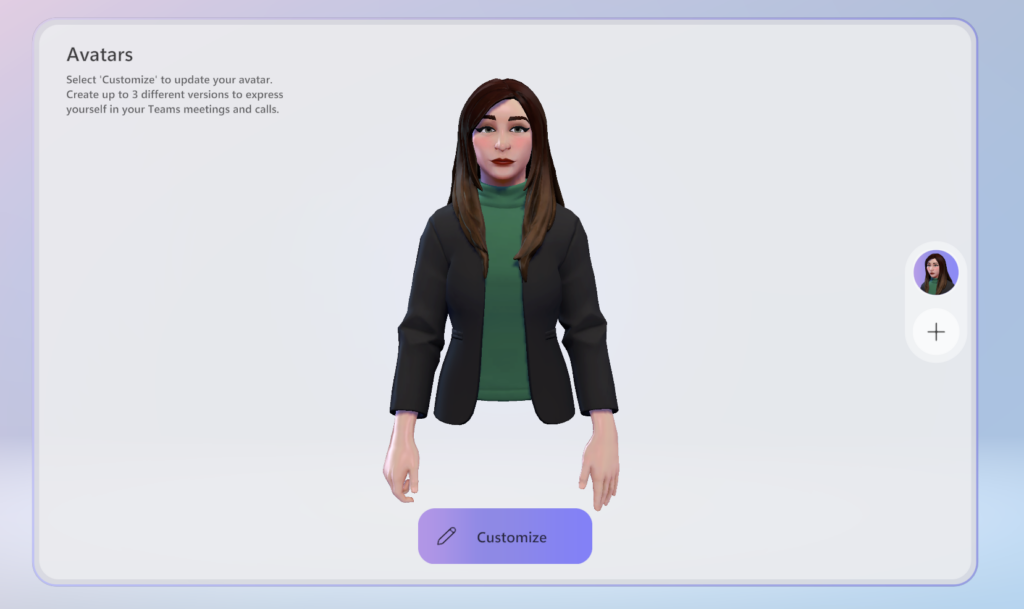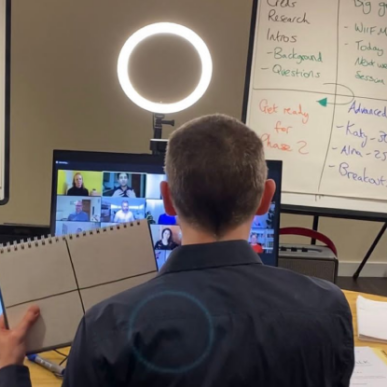Just when you thought you’d got to grips with the technology for your online meetings, a new feature comes along that offers up yet another way to communicate. This time, that feature is using avatars on virtual calls.
Avatars – or virtual representations of yourself – are becoming more common on video conferencing platforms as a way to appear online. When joining a meeting, you can now choose between attending with your camera on, having audio only or using an avatar to represent your speech and body language.
But are avatars on virtual calls a genuinely useful tool for communication or simply a technological novelty that’s fun to play with? Let’s take a look.
What is an avatar?
An avatar is your digital alter ego. It’s like a little virtual version of yourself that you create to represent you online. Typically it looks like a 3D cartoon character that you design to look like you.
In most cases, you can customise your avatar’s appearance, choosing everything from its skin, hair and eye colour to its clothes, make up and piercings to make it look like you.
Your avatar acts as your animated online identity, allowing you to interact with others and navigate virtual spaces in a way that feels personal and fun.
Until recently, avatars have typically been used in online gaming and social media, but now video conferencing platforms are rolling them out as a communication choice for delegates in online meetings.
Avatars on virtual calls
On a virtual call, your avatar appears instead of your video camera picture. When you talk, your avatar’s mouth moves at the same time and there are a range of body language expressions and gestures that you can choose from to show your reaction to what’s being said during the meeting. Clapping hands, tapping a watch, yawning and even showing delight with a “chef’s kiss” are a couple of clicks away.

Avatars are becoming increasingly popular amongst video conferencing software companies, who are promoting their use with a view to shifting users towards the mixed reality of the metaverse.
For example, in the last year, Microsoft has rolled out the option of using avatars on Teams platform. Users can customise their own avatar in granular detail, changing the shape of their facial features, body and clothes so that they can best represent themselves. If your avatar’s forehead seems a bit too wide, a slider can make it narrower. Eyeliner too thick? You can change that at the click of a button. Every element of your avatar is customizable.
Zoom allows users to show up to meetings as a hoodie-wearing rabbit, dog or squirrel, as well as creating a version of themselves in digital ‘human’ form, and Google Meet also allows users to appear as avatars.

Is it a good idea to use avatars on virtual calls?
So with increasing choice of how we represent ourselves in our meetings, when and how should we use avatars on virtual calls? As with any emerging technology, there are a number of advantages and disadvantages to bringing avatars into our business lives.
Let’s take a look at some of the reasons why people might choose to use an avatar, and some of the drawbacks that you need to be aware of.
What are the benefits of using avatars on a virtual call?
Studies have identified several benefits of using avatars on a virtual call.
1. People feel more engaged
Avatars can increase individual feelings of engagement in a meeting. Some studies have shown that having an avatar can enhance participants’ feelings of being present on a call if the only alternative would be to use audio. It can make participants feel more ‘seen’ by other people on the call and, in some circumstances, can actually help to increase trust when the avatar is seen to be ‘reacting’ in a way that the user would if you could see them.
2. Increased self-confidence
One main reason many people feel positive about avatars is when they want to hide their visual appearance. Avatars can help to increase confidence and the feeling of being ‘part’ of a meeting without the fatigue of being ‘seen’ on camera for long periods of time. If everyone is using an avatar, it can also bring a sense of equality to a meeting.
3. Technical benefits
There are some technical benefits of using avatars, too. Whilst video calls can often cut out or freeze if the internet connection is poor, avatars typically take up lower bandwidth. This means that a video conference connection could be more stable and reliable when using an avatar.
4. The fun factor!
Of course, it’s worth mentioning, avatars are fun! Don’t take my word for it – all you need to do is to sit down in front of an avatar generator and see how much time you can spend customising and ‘trying out’ the different looks. They can be a great ice breaker and talking point during ‘lighter’ conversations.
What are the disadvantages of using avatars on a virtual call?
While avatars offer numerous advantages in virtual communication, such as personalization and engagement, they also come with some disadvantages:
1. Loss of non-verbal cues
Avatars often lack the subtlety of real-life nonverbal communication, such as facial expressions, gestures, and body language. Even when users are able to ‘click to react’ during a conversation or meeting, it cannot substitute the nuance of human movement This can lead to misunderstandings or misinterpretations during virtual interactions, as participants may struggle to convey or interpret emotions accurately. Also, there are a limited number of ‘reactions’ that an avatar can generate, meaning that opportunities to show genuine emotion and engagement are lost.
2. Lack of trust through decreased authenticity
Avatars may not fully capture the authenticity of a person’s identity or appearance. Even with customization options, avatars may feel artificial or disconnected from the individual they represent, potentially impacting the sense of trust and rapport in virtual relationships.
3. Distraction from main message
Avatars can be fun to use, but their novelty can be a distraction. If people are focusing too much on what they want their avatar to ‘do’ in reaction, there’s a real likelihood that parts of the message they should be hearing are being lost.
4. Technical limitations
Avatars may be subject to technical limitations, such as limited customization options, graphical glitches, or compatibility issues across devices. These technical constraints can detract from the overall user experience and hinder effective communication.
5. Inappropriateness of tone
Depending on the nature of the call or conversation, seeing an avatar instead of a human could come across as being wildly inappropriate. Imagine a very difficult call in which someone was delivering bad news to you. How would you feel if that was being delivered by an avatar? Sometimes, only human faces will do. Even though users can choose reactions for avatars, in most circumstances, avatars can ‘move a little bit’ on their own. This increases the chance of someone inadvertently giving an inappropriate reaction.

When should I use an avatar on a virtual call?
Although there are no set-in-stone rules about virtual calls, having your video camera on will usually be the best option. This will allow other people in your meeting to see your body language and will help to give the ultimate clarity to your message, as well as increasing trust.
In a recent blog post, Microsoft has explained the etiquette around how its employees use avatars in Teams meetings. At Microsoft, employees use avatars in more informal lunch-and-learn sessions, ideation sessions and weekly catch ups with colleagues on their immediate teams.
Never use avatars for one-on-one meetings, performance reviews or sensitive conversations.
If you do choose to use an avatar, be very considerate about which moves and reactions you display. Deliberately ‘yawning’ or giving a ‘chef’s kiss’ during someone’s presentation may seem fun to you, but unless you are absolutely certain about how your reaction will be interpreted, it may be wise to make your avatar move less.
Best practice for online meetings
In most circumstances, joining an online meeting with your camera on will give you the best opportunity to communicate your message clearly and engage your audience, as people will be able to read your body language and facial expressions as well as hear your content.
Make sure your camera height is adjusted to ensure your head, shoulders and hands are in the shot. Ensure there’s enough light on your face so that the webcam can see you, and use an external microphone to give high quality sound.
If you do feel self-conscious about your appearance or if you find it distracting, turn off your self view.
The bottom line: use avatars sparingly
In short, avatars are great fun to use on occasion. For a casual team meet up or something informal, they can lighten the atmosphere and break the ice. They can spark conversation and can increase engagement, but still lack that genuine human engagement that they are trying to emulate.
If you’ve got the chance to appear as the real you, it’s always going to be the better option: it’s more transparent, more readable and ultimately, more human – and that’s where the real engagement comes from.





















